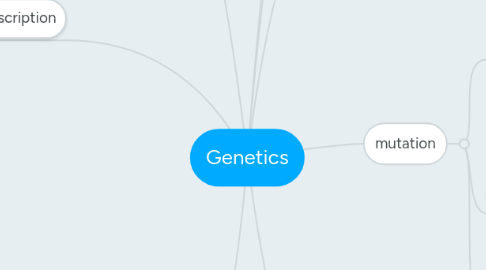
1. transcription
1.1. synthesis of complementary strand of RNA from a DNA template
1.2. 3 key materials: (1)DNA template [coding/sense strand] (2)RNA polymerase (3)supply of ribonucleotides
1.3. location: nucleus
1.4. process
1.4.1. initiation
1.4.1.1. RNA polymerase binds to the DNA ar promoter, unwind DNA
1.4.2. elongation
1.4.2.1. (1)RNA moves towards the 5'end; (2)ribonucleotides are added to the 3'-OH end; (3)the new RNA molecule is synthesised in the 5'to3' direction
1.4.3. termination
1.4.3.1. RNA polymerase reaches terminator
1.5. product
1.5.1. triplets of nucleotides--codon
1.5.1.1. specific amino acids/stop signal--genetic code
2. translation
2.1. conversion of codons of mRNA into protein
2.2. 3 key materials: (1)ribosome (2)mRNA transcript (3)tRNA (anti-condo)
2.3. location: cytoplasm (roughER)
2.4. process
2.4.1. codon recognition
2.4.1.1. the first tRNA binds to the start codon, bringing with it the amino acid
2.4.2. peptide bond formation
2.4.2.1. the first amino acid is transferred over to the second tRNA by the ribosome; the ribosome joins the two amino acids with a peptide bond
2.4.3. translocation
2.4.3.1. the ribosome moves along the mRNA towards the 3'end; a polypeptide chain results
2.4.4. termination
2.4.4.1. reaching the stop codon
3. biotechnology
3.1. genetic engineering & gene cloning
3.1.1. gene cloning plasmid
3.1.1.1. origin of replication [allow plasmid to replicate independently]
3.1.1.2. selection maker [identify cells with/without the gene of interest]
3.1.1.3. cloning site
3.1.2. insertion of gene of interest
3.1.2.1. restriction enzyme
3.1.2.1.1. cuts the DNA to fragments with complementary sticky ends
3.1.2.2. ligase
3.1.2.2.1. seals the strands formed by DNA fragments with complementary sticky ends to form recombinant DNA moecules
3.1.3. cultivation
4. monohybrid inheritance
4.1. testcross
5. complex patterns of inheritance
5.1. complete dominance
5.2. incomplete dominance
5.2.1. F1 hybrids have a phenotype in between 2 parental phenotypes
5.3. co-dominance
5.3.1. single phenotypic character determined by more than 2 alleles
5.3.1.1. blood type
5.4. polygenic inheritance
5.4.1. single phenotypic character determined by more than 1 gene
5.5. sex-linked inheritance
5.5.1. X-linked genes
5.5.1.1. female--only homozygote; male--receive recessive allele from his mother
6. variation
6.1. continuous variation
6.1.1. influenced by the envrionment
6.1.2. no distinct catagories
6.1.3. controlled by a lot of genes
6.2. discontinuous variation
6.2.1. unaffected by the environment
6.2.2. distinct catagories
6.2.3. controlled by a few genes
7. mutation
7.1. at gene level
7.1.1. base-pair insertion
7.1.2. base-pair deletion
7.1.3. base-pair substitutions
7.1.3.1. silent mutations
7.1.3.1.1. have no effect on the encoded protein
7.1.3.2. missense mutations
7.1.3.3. nonsense mutations
7.1.3.3.1. cause termination; shorten polypeptide; lead to non-functional proteins
7.2. at chromosome level
7.2.1. non-disjunction
7.2.1.1. monosomy
7.3. mutagens
7.3.1. chemical
7.3.1.1. ethidium bromide
7.3.2. physical
7.3.2.1. ionising radiation, S-rays, UV-rays, gamma rays
7.3.3. biological
7.3.3.1. errors during DNA replication, repair or recombination
8. evolution
8.1. natural selection
8.1.1. a process in which individuals that have certain heritable characteristics survive and reproduce at a higher rate than other individuals
8.2. artificial selection
8.2.1. a wide variety of plants and animals with desirable traits in a short period of time
8.2.2. inbreeding--an accumulation of harmful recessive alleles
